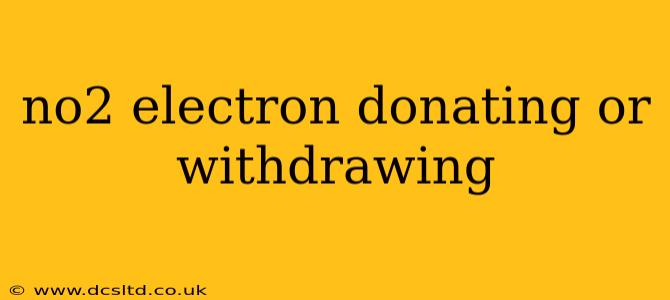The nitro group (-NO2) is a fascinating functional group in organic chemistry, known for its significant impact on the reactivity of molecules it's attached to. A common question arising in organic chemistry courses and research is: is NO2 electron donating or withdrawing? The answer is nuanced and depends on the mechanism being considered.
Understanding Electron Donation and Withdrawal
Before diving into the specifics of the nitro group, let's clarify the concepts of electron donation and withdrawal. These terms describe how a substituent influences the electron density of a molecule, particularly within the conjugated π system.
-
Electron-donating groups (EDGs): These groups increase the electron density in the ring or molecule. They typically possess lone pairs of electrons or are less electronegative than carbon. Examples include -OH, -NH2, and -OCH3.
-
Electron-withdrawing groups (EWGs): These groups decrease the electron density in the ring or molecule. They are usually electronegative atoms or groups containing electronegative atoms. Examples include -NO2, -CN, and -COOH.
The Nitro Group: A Powerful Electron Withdrawing Group
The nitro group (-NO2) is unequivocally an electron-withdrawing group through resonance and inductive effects. Let's examine each:
1. Inductive Effect
The inductive effect is the polarization of sigma (σ) bonds due to the electronegativity difference between atoms. Oxygen is significantly more electronegative than nitrogen and carbon. This electronegativity pulls electron density away from the carbon atom it's attached to, making the nitro group inductively electron-withdrawing.
2. Resonance Effect
The resonance effect is even more impactful. The nitro group possesses a delocalized π system. One of the oxygen atoms can donate a lone pair of electrons to form a double bond with the nitrogen. This results in a positive charge on the nitrogen and a negative charge on one of the oxygens. The resonance structures show a net withdrawal of electron density from the attached carbon atom. This makes the nitro group a strong electron-withdrawing group through resonance.
How NO2 Affects Reactivity: A Deeper Dive
The electron-withdrawing nature of the nitro group significantly impacts the reactivity of molecules. Here are some key observations:
-
Electrophilic Aromatic Substitution: The nitro group is deactivating in electrophilic aromatic substitution reactions. This means it makes the ring less susceptible to electrophilic attack. This is because the electron-withdrawing effect reduces the electron density of the aromatic ring, making it less attractive to electrophiles.
-
Nucleophilic Aromatic Substitution: The nitro group can activate nucleophilic aromatic substitution reactions in specific cases. The electron-withdrawing effect stabilizes the negative charge that develops on the ring during the reaction, facilitating the substitution.
-
Acidity/Basicity: The presence of a nitro group can significantly increase the acidity of a molecule by stabilizing the resulting conjugate base.
Addressing Common Questions
Here are answers to some frequently asked questions about the nitro group's electron-withdrawing properties:
Is NO2 a meta director?
Yes, due to its electron-withdrawing nature, the nitro group is a meta-director in electrophilic aromatic substitution reactions.
How does NO2 affect the basicity of aniline?
The nitro group significantly reduces the basicity of aniline. The electron-withdrawing effect reduces the electron density on the nitrogen atom, making it less available to accept a proton.
Does the nitro group participate in hyperconjugation?
While the primary electron-withdrawing effects are inductive and resonance, the nitro group can have a minor contribution from hyperconjugation, especially when attached to an alkyl group. However, this effect is generally overshadowed by the much stronger inductive and resonance effects.
In summary, the nitro group is a powerful electron-withdrawing group due to both inductive and resonance effects. Understanding this property is crucial to predicting and interpreting the reactivity of molecules containing this functional group.
